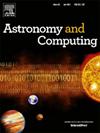Geometric analysis of variability of radiocarbon abundances and solar activity
IF 1.8
4区 物理与天体物理
Q2 ASTRONOMY & ASTROPHYSICS
引用次数: 0
Abstract
This paper discusses a geometric time series analysis of variability of radiocarbon abundances and solar activity. Cosmic rays sometimes have a severe impact on the Earth’s environment. They interact with atoms in the atmosphere, producing radionuclides such as radiocarbon. Consequently, the ratio of radiocarbon to stable carbon in the atmosphere fluctuates on the basis of the influx of cosmic rays. Consequently, historical records of radiocarbon abundances show the intensity of cosmic rays in the past. The International Calibration (IntCal) curve widely used for radiocarbon dating is also used as a reference for such records. From a statistical point of view, detecting rapid changes in radiocarbon abundances, which are considered indicators of intense cosmic rays, from the IntCal data is challenging because such variations are generally smoothed out during the calibration process. However, in this study, we used a geometric time series analysis method to identify several rapid changes directly from the IntCal data. These variations in radiocarbon abundances also serve as indicators of solar activity. We also detected signals corresponding to solar grand minima and grand maxima by correlating them with temporal changes in the vector field derived from the dynamical system characterized by a second-order random oscillation.
放射性碳丰度变化和太阳活动的几何分析
本文讨论了放射性碳丰度和太阳活动变化的几何时间序列分析。宇宙射线有时对地球环境有严重的影响。它们与大气中的原子相互作用,产生放射性核素,如放射性碳。因此,大气中放射性碳与稳定碳的比例在宇宙射线流入的基础上波动。因此,放射性碳丰度的历史记录显示了过去宇宙射线的强度。广泛用于放射性碳测年的国际校准(IntCal)曲线也被用作此类记录的参考。从统计学的角度来看,从IntCal数据中检测放射性碳丰度的快速变化是具有挑战性的,因为这种变化通常在校准过程中被平滑。放射性碳丰度被认为是强烈宇宙射线的指标。然而,在本研究中,我们使用几何时间序列分析方法直接从IntCal数据中识别出几个快速变化。这些放射性碳丰度的变化也可以作为太阳活动的指标。我们还通过将太阳极大极小期和极大期的信号与由二阶随机振荡特征的动力系统导出的矢量场的时间变化相关联,检测到它们对应的信号。
本文章由计算机程序翻译,如有差异,请以英文原文为准。
求助全文
约1分钟内获得全文
求助全文
来源期刊

Astronomy and Computing
ASTRONOMY & ASTROPHYSICSCOMPUTER SCIENCE,-COMPUTER SCIENCE, INTERDISCIPLINARY APPLICATIONS
CiteScore
4.10
自引率
8.00%
发文量
67
期刊介绍:
Astronomy and Computing is a peer-reviewed journal that focuses on the broad area between astronomy, computer science and information technology. The journal aims to publish the work of scientists and (software) engineers in all aspects of astronomical computing, including the collection, analysis, reduction, visualisation, preservation and dissemination of data, and the development of astronomical software and simulations. The journal covers applications for academic computer science techniques to astronomy, as well as novel applications of information technologies within astronomy.
 求助内容:
求助内容: 应助结果提醒方式:
应助结果提醒方式:


